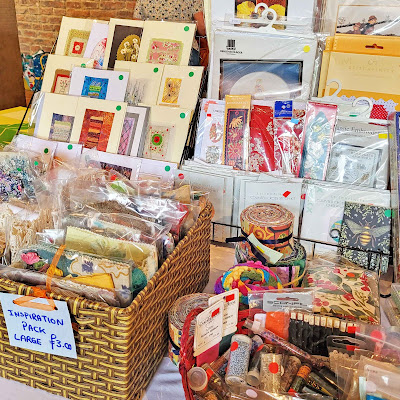.jpg) |
| The Red Dress |
I have just been to see "The Red Dress" which is currently on display at Oakwell Hall in Birstall, West Yorkshire as part of the Woven in Kirklees festival. It is truly magnificent!
.jpg) |
| The Red Dress - Detail |
.jpg) |
| The Red Dress - Detail |
The dress was created between 2009 and 2023 by 380 embroiderers from 51 countries and is made from 87 panels of silk. The project was instigated by artist Kirsty Macleod as a platform for people around the world, mostly women, to say something about their lives and their identities.
.jpg) |
| The Red Dress - Detail |
.jpg) |
| The Red Dress - Detail |
Some of the participants have experienced war, extreme poverty, being refugees or asylum seekers. As a result the dress has become a focal point allowing these stories to be heard and to encourage dialogue on such important but difficult topics.
.jpg) |
| The Red Dress - Detail |
.jpg) |
| The Red Dress - Detail |
Many of the embroiderers who worked on the dress are textile professionals and were paid for their work and continue to receive some income from project sales. They may have used techniques reflecting their culture and traditions or simple stitches to portray their personal experiences.
.jpg) |
| The Red Dress - Detail |
.jpg) |
| The Red Dress - Detail |
It is estimated that the dress contains 1-1.5 billion stitches, and weighs 6.8 kg. It is made of burgundy silk dupion. The project has many funders, including institutions, charities, social enterprises, self help projects, crowd funding campaigns and private donations.
 |
| Views of the Red Dress |
If you want to hear Kirsty talk about the Red Dress project, she is giving an online talk as part of the Embroiderers' Guild Thread Talks series on Tuesday 16 September 2025. You can book here.
 |
Oakwell Hall
Panelling painted to look like walnut, Westmorland bed adorned with modern crewelwork by Oakwell Broiderers, roof revealed to show oak timbers and stone tiles |
Oakwell Hall, which is not far from Ikea on the M62 - if that helps you locate it, is an Elizabethan Manor in extensive grounds with a nice cafe and a car park. It was built in 1583 by John Batte and "Fieldhead", in Charlotte Brontë's novel Shirley, was based on Oakwell Hall. It's worth a visit on its own but a must while the Red Dress is on display. During this exhibition, which ends on 30 June 2025, the Hall is open Saturday to Wednesday, 12 noon - 4pm. Entry is free and although priority tickets have gone, you are still able to visit but may have to queue.
.jpg)


.jpg)
.jpg)
.jpg)
.jpg)


.jpg)
.jpg)
.jpg)
.jpg)
.jpg)
.jpg)
.jpg)
.jpg)
.jpg)
.jpg)
.jpg)
.jpg)


.jpg)
.jpg)
.jpg)
.jpg)
.jpg)
.jpg)
.jpg)
.jpg)
.jpg)
.jpg)
.jpg)



.jpg)
.jpg)
.jpg)
.jpg)
.jpg)
.jpg)
.jpg)
.jpg)
.jpg)
.jpg)
.jpg)
.jpg)
.jpg)
.jpg)
.jpg)